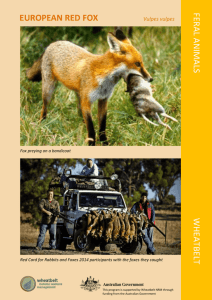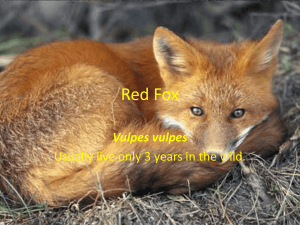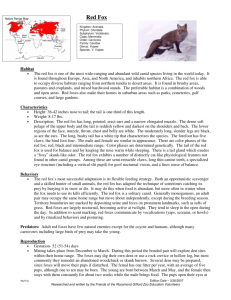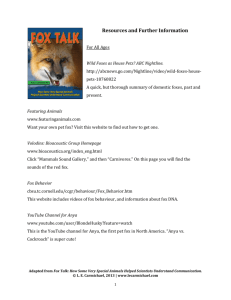Distribution of Nonnative Red Foxes in East Bay Oak Woodlands
advertisement
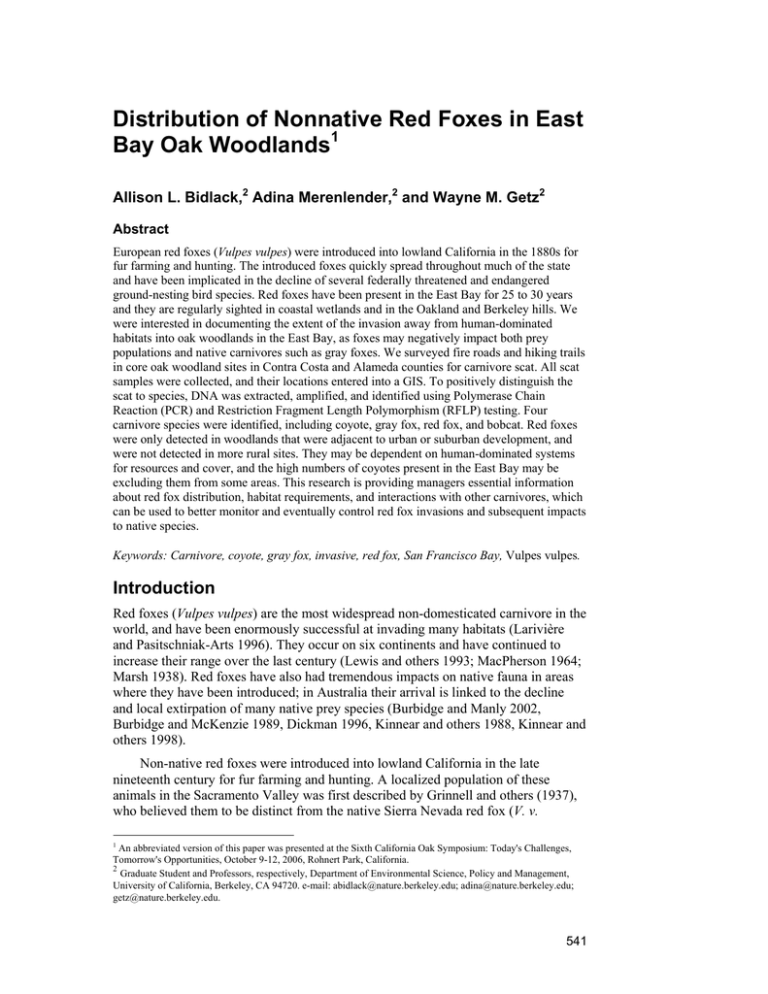
Distribution of Nonnative Red Foxes in East Bay Oak Woodlands1 Allison L. Bidlack,2 Adina Merenlender,2 and Wayne M. Getz2 Abstract European red foxes (Vulpes vulpes) were introduced into lowland California in the 1880s for fur farming and hunting. The introduced foxes quickly spread throughout much of the state and have been implicated in the decline of several federally threatened and endangered ground-nesting bird species. Red foxes have been present in the East Bay for 25 to 30 years and they are regularly sighted in coastal wetlands and in the Oakland and Berkeley hills. We were interested in documenting the extent of the invasion away from human-dominated habitats into oak woodlands in the East Bay, as foxes may negatively impact both prey populations and native carnivores such as gray foxes. We surveyed fire roads and hiking trails in core oak woodland sites in Contra Costa and Alameda counties for carnivore scat. All scat samples were collected, and their locations entered into a GIS. To positively distinguish the scat to species, DNA was extracted, amplified, and identified using Polymerase Chain Reaction (PCR) and Restriction Fragment Length Polymorphism (RFLP) testing. Four carnivore species were identified, including coyote, gray fox, red fox, and bobcat. Red foxes were only detected in woodlands that were adjacent to urban or suburban development, and were not detected in more rural sites. They may be dependent on human-dominated systems for resources and cover, and the high numbers of coyotes present in the East Bay may be excluding them from some areas. This research is providing managers essential information about red fox distribution, habitat requirements, and interactions with other carnivores, which can be used to better monitor and eventually control red fox invasions and subsequent impacts to native species. Keywords: Carnivore, coyote, gray fox, invasive, red fox, San Francisco Bay, Vulpes vulpes. Introduction Red foxes (Vulpes vulpes) are the most widespread non-domesticated carnivore in the world, and have been enormously successful at invading many habitats (Larivière and Pasitschniak-Arts 1996). They occur on six continents and have continued to increase their range over the last century (Lewis and others 1993; MacPherson 1964; Marsh 1938). Red foxes have also had tremendous impacts on native fauna in areas where they have been introduced; in Australia their arrival is linked to the decline and local extirpation of many native prey species (Burbidge and Manly 2002, Burbidge and McKenzie 1989, Dickman 1996, Kinnear and others 1988, Kinnear and others 1998). Non-native red foxes were introduced into lowland California in the late nineteenth century for fur farming and hunting. A localized population of these animals in the Sacramento Valley was first described by Grinnell and others (1937), who believed them to be distinct from the native Sierra Nevada red fox (V. v. 1 An abbreviated version of this paper was presented at the Sixth California Oak Symposium: Today's Challenges, Tomorrow's Opportunities, October 9-12, 2006, Rohnert Park, California. 2 Graduate Student and Professors, respectively, Department of Environmental Science, Policy and Management, University of California, Berkeley, CA 94720. e-mail: abidlack@nature.berkeley.edu; adina@nature.berkeley.edu; getz@nature.berkeley.edu. 541 GENERAL TECHNICAL REPORT PSW-GTR-217 necator). Residents from five counties described hunting and trapping these valley foxes beginning in about 1896 (Grinnell and others 1937). Foxes were also imported and released in Orange County for hunting from 1905 to 1919 (Sleeper 1987). Commercial fur farming became very popular in the mid-twentieth century, with approximately 125 fox farms throughout California by the early 1940s (Vail 1942), and many foxes undoubtedly escaped or were released from these farms (Lewis and others 1993). Gray (1975) documented red foxes occupying 16 counties in Northern California, with most sightings occurring in the Sacramento Valley. Gray (1975) also described a population from Los Angeles County, and stated that there were unconfirmed sightings in other Southern California localities. Most recently, Lewis and others (1993) documented the presence of red foxes in 36 counties throughout the state, excluding the North Coast, the Modoc Plateau, and the Mojave Desert. Red foxes have been implicated in the decline in California of several federally threatened and endangered bird species, including the light-footed clapper rail (Rallus longirostris levipes), the California clapper rail (R. longirostris obsoletus), the California least tern (Sterna antillarum browni), and the western snowy plover (Charadrius alexandrinus nivosus; U.S. Fish and Wildlife Service 1990; U.S. Fish and Wildlife Service and U.S. Navy 1990). While depredations of bird populations have been well-documented, less is known about red fox impacts to mammalian prey species and native carnivores. Anecdotal evidence suggests that red foxes have replaced gray foxes (Urocyon cinereoargenteus) in some areas (J. Patton and R. Barrett, pers comm), and that when red fox numbers are reduced, gray fox populations rebound (J. DiDonato, pers comm). Red foxes have also killed several federally endangered San Joaquin kit foxes (Vulpes macrotis mutica; Clark 2001; Ralls and White 1995), and there is concern over possible introgression between nonnative red foxes and the Sierra Nevada red fox (Perrine 2005). Red foxes are often associated with human-dominated landscapes and may sustain very high densities in these heterogeneous habitats (Catling and Burt 1995; Kurki and others 1998; Larivière and Pasitschniak-Arts 1996; Oehler and Litvaitis 1996). In urban Orange County, red foxes utilize open spaces such as golf courses, airports and cemeteries (Lewis and others 1993). In North America, predation and competition by coyotes (Canis latrans) may also be important in shaping red fox distributions (Harrison and others 1989; Sargeant and others 1987; Sargeant and Allen 1989; Voigt and Earle 1983). Coyotes tend to avoid urban or developed areas (Gosselink and others 2003; Odell and Knight 2001), and these regions might provide a refuge from coyote predation for red foxes. Since the mid-seventies, non-native red foxes have been present and locally increasing in number around the San Francisco Bay (J. DiDonato, pers comm.; Lewis and others 1993). Counties surrounding the Bay Area support a diverse mix of highand low-density housing, vineyards, oak woodlands, and grasslands, resulting in a complex interface between human-dominated landscapes and wildlands. However, most of the undeveloped land is under private ownership and is subject to intense vineyard and residential development pressure. If red fox dispersal and successful establishment is predicated on landscape conversion, these development pressures may lead to the continued red fox invasion of northern coastal California oak woodlands. Our objective was to evaluate the abundance of red foxes in oak woodlands in Contra Costa and Alameda counties, in order to assess the extent of their spread from human-dominated habitats into wildlands in the East Bay. 542 Distribution of Non-Native Red Foxes in East Bay Oak Woodlands—Bidlack Methods We used a geographic information system (GIS) to select core oak woodland sites in Contra Costa and Alameda counties. Using the State of California Fire and Resource Assessment Program vegetation classification layer, along with the Bay Area Open Space Council open space layer, we examined the land cover within a 5 km2 circle around the centroid of each open space polygon. We defined core woodland areas as those circles that contained 25 percent to 75 percent combined hardwood, conifer and shrub cover, of which at least 50 percent was hardwood. These constrictions ensured that grasslands and closed-canopy forests were not included in our site selection and that any cover was predominantly hardwood rather than shrub or conifer. We also eliminated properties with greater than 5 percent water, wetland, urban, or agriculture area. This provided us with 15 oak woodland dominated properties, under a variety of ownerships, for which we eventually obtained permission to survey 12. Six of these properties were sufficiently large enough to conduct two survey transects, making a total of 18 transects (fig. 1). Surveys for red fox were performed using a detection dog trained to locate the scats of all canids and felids, excluding domestic dog. Scat sniffing dogs have proven to be both remarkably efficient and precise in their searching. In prior research, detection dogs have correctly identified 100 percent of target carnivore scats in a matrix of sympatric species (Smith and others 2001, 2003) and have detected the Figure 1—Location map of survey transects in the East Bay. BDM1 and BDM2, Black Diamond Mines Regional Park; BR1 and BR2, Briones Regional Park; CAR, Carnegie State Vehicular Recreation Area; CLAY, Clayton Land Bank; GDC1 and GDC2, Garin/Dry Creek Regional Park; MT1 and MT2, Morgan Territory Regional Park; OHL, Ohlone Wilderness; PLR1 and PLR2, Pleasanton Ridge Regional Park; RV, Round Valley Regional Park; SR, Sky Ranch; SUN1 and SUN2, Sunol Regional 543 GENERAL TECHNICAL REPORT PSW-GTR-217 Wilderness; and VAR, Vargas Land Bank. Sunburst symbol represents sites where red foxes were found. Dark gray color represents urban areas, light gray is oak woodlands. presence of target species regardless of species density or vegetation type (Smith and others 2005). In a controlled test, our dog detected 100 percent of scats placed within 10 m of the centerline of a transect along an unpaved road, and 98 percent of scats within 20 m (Reed and Bidlack 2006). A pilot survey indicated that in these oak woodland systems, most canid scats are deposited along trails, with surveying and collection off-trail extremely difficult and inefficient (Bidlack Unpublished data). Therefore, surveys were conducted along fire roads, and hiking and game trails. Transect start points and direction were chosen randomly within the site, which means that the land cover around the transect may differ slightly from that around the centroid of the site. Each transect was 2-km long, and all transects were separated by at least 2.5 km to increase independence of sampling (red fox home ranges vary widely, but average 5 square km [Larivière and Pasitschniak-Arts 1996]). Due to time and financial constraints, each transect was surveyed only once. Collected scats were individually bagged and given an identification number and a GPS location and subsequently stored at -800 C. Scats were later identified to species using molecular genetic methods. DNA was extracted from each scat using a small sub-sample (~500 g) that was removed from the outer surface or end of each feces and used in a QIAamp DNA stool kit (Qiagen). Polymerase chain reaction (PCR) was then used to amplify a 196 base pair segment of the mitochondrial cytochrome b gene. Restriction fragment length polymorphism (RFLP) analysis using three restriction enzymes (HpaII, DdeI and HpyCh4V) to cut this fragment was used to separate coyote, gray fox, red fox, and bobcat scats (for protocols see Bidlack and others 2006). Results and Discussion Eighteen 2-km transects were surveyed during the summer of 2005. We collected a total of 383 scats, with a mean of 21.3 scats found per transect, and with a range of 5 to 48. There was a mean of 12.48 (± 8.83 s.d.) scats located per km. Using molecular methods we identified 353 scats (92 percent) to species. Coyote scat was the most prevalent at 222 (62 percent), followed by gray fox at 93 (26 percent), bobcat at 35 (10 percent), and red fox at three (1 percent). Coyotes were detected at all sites, while bobcats and gray fox were detected at 11 and 7 sites, respectively. Red fox scats were found at only two sites, Vargas Plateau and Garin/Dry Creek, both in Alameda County (fig. 1). Our study indicates that red foxes have not been particularly successful in invading core oak woodlands in the East Bay. This may be the result of several factors, one of which is the amount and pattern of development. Most previous research in other regions suggests that red foxes are closely associated with disturbed or heterogeneous habitats. In Australia, red foxes only occur in forested patches close to areas that have been cultivated, heavily grazed, burned, logged, or converted to residential development (Catling and Burt 1995). In Europe, red foxes are most abundant in landscapes including 20 to 30 percent agricultural land (Kurki and others 1998). Urban areas may provide reliable sources of food, water, and cover for foxes; in fact, local residents provided red foxes with supplemental food at every site studied in Orange County (Lewis and others 1993). The two sites in which red fox 544 Distribution of Non-Native Red Foxes in East Bay Oak Woodlands—Bidlack scats were found in our study were both near developed areas. Vargas Plateau is a working cattle ranch, and Garin/Dry Creek Park directly abuts a dense residential neighborhood, unlike all the other sites (some of which are adjacent to low-density suburban developments). Another recent survey for foxes conducted in grasslands (<25 percent canopy cover) in eastern Alameda and Contra Costa counties indicates that red foxes may persist only near permanent water sources such as reservoirs and canals (Clark and others 2003; Smith and others 2006). This study surveyed 17 sites in these two counties and detected red foxes at only three sites, again confirming that this species has on the whole not been successful in invading wildlands in Northern California (Clark and others 2003; Smith and others 2006). Red foxes may not be able to persist in wildlands far from developed areas, though they may survive in the same types of habitats close to human development. This pattern has been observed in other human-associated species (for example, domestic cats, cowbirds; Hejl and others 2002; Maestas and others 2003; Morrison and Hahn 2002; Odell and Knight 2001). If red fox occupancy patterns reflect a reliance on human development, then conserving large patches of undeveloped oak woodland habitat in the East Bay may help buffer these habitats against invasion by red fox. The high numbers of coyotes in the East Bay may also be excluding red foxes from some areas, or keeping their abundance low. Coyotes are known to kill red foxes (Sargeant and Allen 1989), and red foxes will avoid areas with high densities of coyotes (Harrison and others 1989; Sargeant and others 1987; Voigt and Earle 1983). We found coyote scats on all of our transects, indicating that they are ubiquitous in oak woodlands in the Bay Area. We found no relationship between coyote abundance and distance of the transect from developed areas. However, we found coyote scats on the same transects with red fox scats. Currently, the relationship between these two species is still unclear, and it is impossible to differentiate between coyote presence and lack of development as impediments to red fox spread into core woodlands. Similarly, we remain uncertain concerning the interaction between gray and red foxes in these sites, in view of the fact that we found gray fox scats at both of the sites that also supported red fox. Recently, presence/absence surveys have come under criticism for a general lack of detection rate estimates, leading to biased approximations of habitat occupancy (MacKenzie and others 2006, and papers cited therein). However, surveys performed by scat detection dogs are likely to detect more species and more samples per species, especially for rare taxa, than other non-invasive survey methods such as searching by humans, track plates, remote cameras, and hair snares (Harrison and others 2002; Smith and others 2001). We made the assumption that all species were defecating on roads and trails, and that there would be no detection bias by the dog among the target species. Our findings concerning red fox occurrence are corroborated by the results of Smith and others (2006), who surveyed some of the same properties (Black Diamond Mines, Round Valley, Carnegie State Recreation Area) using a scatdetection dog, with negative results. Nevertheless, our surveys may be an underestimate of species presence, given that transects were only surveyed once. Our preliminary data suggest that in the East Bay red foxes have successfully established populations only in core oak woodlands adjacent to human development. Further research is needed to better quantify the habitat correlates of red fox as well as to tease apart the relationships among the three canid species in the area. In this way we may gain insight into the drivers of the red fox invasion, and the possible impact of future development on the spread of this exotic species. 545 GENERAL TECHNICAL REPORT PSW-GTR-217 Acknowledgments We thank the East Bay Regional Park District, the Muir Heritage Land Trust, and California State Parks for permission to survey their properties. We are also grateful to Dr. Per Palsbøll for generously allowing us to use his genetics laboratory. This work was supported by an American Society of Mammalogists Grant-in-aid of Research to ALB. References Bidlack, A.L.; Reed, S.E.; Palsbøll, P.J.; Getz, W.M. 2007. Characterization of a western North American carnivore community using PCR-RFLP of cytochrome b obtained from fecal samples. Conservation Genetics 8: 1511-1513. Burbidge, A.A.; McKenzie, N.L. 1989. Patterns in the modern decline of Western Australia’s vertebrate fauna: causes and conservation implications. Biological Conservation 50: 143-198. Burbidge, A.A.; Manly, B.F. 2002. Mammal extinctions on Australian islands: causes and conservation implications. Journal of Biogeography 29: 465-473. Catling, P.C.; Burt, R.J. 1995. Why are red foxes absent from some eucalypt forests in eastern New South Wales? Wildlife Research 22: 535-546. Clark, H.O. 2001. Endangered San Joaquin kit fox and non-native red fox: interspecific competitive interactions. Fresno, CA: California State University; 84 p. M.S. thesis. Clark, H.O.; Smith, D.A.; Cypher, B.L.; Kelly, P.A. 2003. Detection dog surveys for San Joaquin kit foxes in the northern range. Fresno, California: Endangered Species Recovery Program. 37 p. Contract number 4600013447. Dickman, C.R. 1996. Impact of exotic generalist predators on the native fauna of Australia. Wildlife Biology 2: 185-195. Gosselink, T.E.; Van Deelen, T.R.; Warner, R.E.; Joselyn, M.G. 2003. Temporal habitat partitioning and spatial use of coyotes and red foxes in east-central Illinois. Journal of Wildlife Management 67: 90-103. Gray, R.L. 1975. Sacramento Valley red fox survey. Non-game wildlife investigation progress report. Sacramento: California Department of Fish and Game. 6 p. Grinnell, J.; Dixon, J.S.; Linsdale, J.M. 1937. Furbearing mammals of California. Berkeley: University of California Press; 777 p. Harrison, D.J.; Bissonette, J.A.; Sherburne, J.A. 1989. Spatial relationships between coyotes and red foxes in eastern Maine. Journal of Wildlife Management 53: 181-185. Harrison, R.L.; Barr D.J.; Dragoo, J.W. 2002. A comparison of population survey techniques for swift foxes (Vulpes velox) in New Mexico. American Midland Naturalist 148:320-337. Hejl, S.J.; Mack, D.E.; Young, J.S.; Bednarz, J.C.; Hutto, R.L. 2002. Birds and changing landscape patterns in conifer forests of the north-central Rocky Mountains. Studies in Avian Biology 25:113-129. Kinnear, J.E.; Onus, M.L.; Bromilow, R.N. 1988. Fox control and rock wallaby population dynamics. Australian Wildlife Research 15: 435-477. Kinnear, J.E.; Onus, M.L.; Sumner, N.R. 1998. Fox control and rock wallaby dynamics II. An update. Wildlife Research 25: 81-88. 546 Distribution of Non-Native Red Foxes in East Bay Oak Woodlands—Bidlack Kurki, E.G.; Nikula, A.; Helle, P.; Linden, H. 1998. Abundances of red fox and pine marten in relation to the composition of boreal forest landscapes. Journal of Animal Ecology 67: 874-886. Lariviere, S.; Pasitschniak-Arts, M. 1996. Vulpes vulpes. Mammalian Species 1-11. Lewis, J.C.; Sallee, K.L.; Golightly Jr., R.T. 1993. Introduced red fox in California. NonGame Bird and Mammal Section Report 93-10. Sacramento: California Department of Fish and Game. 70 p. MacKenzie, D.I.; Nichols, J.D.; Royle, J.A.; Pollock, K.H.; Bailey, L.L; Hines, J.E. 2006. Occupancy Estimation and Modeling: inferring patterns and dynamics of species occurrence. Oxford: Elsevier, Inc.; 324 p. MacPherson, A.H. 1964. A northward range extension of the red fox in the eastern Canadian arctic. Journal of Mammalogy 45: 138-140. Maestas, J.D.; Knight, R.L.; Gilgert, W.C. 2003. Biodiversity across a rural land-use gradient. Conservation Biology 17: 1425-1434. Marsh, D.B. 1938. The influx of the red fox and its colour phases into the barren lands. Canadian Field-Naturalist 52: 60-61. Morrison, M.L.; Hahn, D.C. 2002. Geographic variation in cowbird distribution, abundance and parasitism. Studies in Avian Biology 25:65-72. Odell, E.A.; Knight, R.L. 2001. Songbird and medium-sized mammal communities associated with exurban development in Pitkin County, Colorado. Conservation Biology 15: 1143-1150. Oehler, J.D.; Litvaitis, J.A. 1996. The role of spatial scale in understanding responses of medium-sized carnivores to forest fragmentation. Canadian Journal of Zoology 74: 2070-2079. Perrine, J.D. 2005. Ecology of red fox (Vulpes vulpes) in the Lassen Peak region of California, U.S.A. Berkeley, CA: University of California. Ph.D. dissertation. Ralls, K.; White, P.J. 1995. Predation on San Joaquin kit foxes by larger canids. Journal of Mammalogy 76: 723-729. Reed, S.E.; Bidlack, A.L. 2006. Optimizing field surveys using wildlife detection dogs. Unpublished draft. Sargeant, A.B.; Allen, S.H.; Hastings, J.O. 1987. Spatial relations between sympatric coyotes and red foxes in North Dakota. Journal of Wildlife Management 51: 285-293. Sargeant, A.B.; Allen, S.H. 1989. Observed interactions between coyotes and red foxes. Journal of Mammalogy 70: 631-633. Sleeper, J. 1987. Bears to briquets: a history of Irvine Park 1897-1997. Trabuco Canyon, CA: California Classics; 32 p. Smith, D.A.; Ralls, K.; Davenport, B.; Adams, B.; Maldonado, J.E. 2001. Canine assistants for conservationists. Science 291: 435. Smith, D.A.; Ralls, K.; Hurt, A.; Adams, B.; Parker, M.; Davenport, B.; Smith, M.C.; Maldonado, J.E. 2003. Detection and accuracy rates of dogs trained to find scats of San Joaquin kit foxes (Vulpes macrotis mutica). Animal Conservation 6: 339-346. Smith, D.A.; Ralls, K.; Cypher, B.L.; Maldonado, J.E. 2005. Assessment of scat-detection dog surveys to determine kit fox distribution. Wildlife Society Bulletin 33: 897-904. Smith D.A.; Ralls, K.; Cypher, B.L.; Clark, H.O.; Kelly, P.A.; Williams, D.F.; Maldonado, J.E. 2006. Relative abundance of endangered San Joaquin kit foxes (Vulpes macrotis mutica) based on scat-detection dog surveys. Southwestern Naturalist 51: 210-219. 547 GENERAL TECHNICAL REPORT PSW-GTR-217 U.S. Fish and Wildlife Service. 1990. Predator management plan and environmental assessment, San Francisco Bay National Wildlife Refuge. Draft report. Newark, CA. 26 p. U.S. Fish and Wildlife Service; U.S. Navy. 1990. Endangered species management and protection plan, Naval Weapons Station - Seal Beach and Seal Beach National Wildlife Refuge. Final Environmental Impact Statement. Portland, OR. 591 p. Vail, E.L. 1942. Fox ranching in southern California. California Fish and Game 28: 87-88. Voigt, D.R.; Earle, B.D. 1983. Avoidance of coyotes by red fox families. Journal of Wildlife Management 47: 852-857. Continue 548
